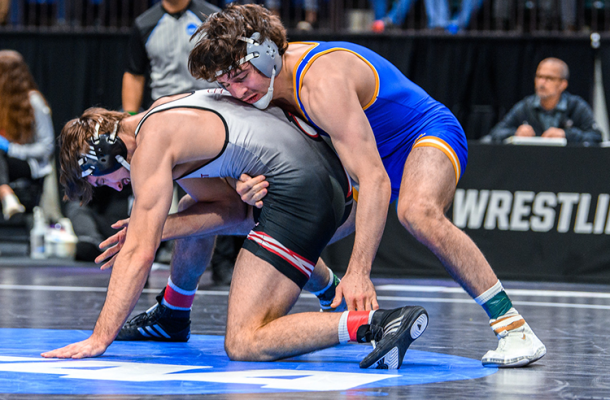New NCAA rule changes don’t make sense or seem fair

Photo: Among the new NCAA rules, wrestlers in the future will no longer be able to secure riding time with the aid of grabbing an ankle without a stalling count being initiated. (Tony Rotundo photo)
By Tristan Warner
The new NCAA rule changes for the 2023-24 season leave me with a feeling of uneasiness that I feel obligated to explore further.
I know some of the opinions to follow may be unpopular with wrestling fans across the country, but perhaps these thoughts may generate some healthy dialogue.
For starters, at times, it feels like the committee is just searching for something to change, whether it be something trivial like the requirement for beard length, or something massive like applying a multiplier of 1.5x to the most fundamental aspect of scoring in the sport of wrestling.
I understand the effort to “grow the sport” and make it more appealing for fans is important. However, I also see how the reality of constantly changing the rules also confuses the casual wrestling fan or keeps a newcomer from ever really grasping the concepts and scoring principles.
Case in point, I know several people who, just by virtue of living in central Pennsylvania and being Penn State fans, have started to gravitate toward the sport and become more interested in it as Penn State’s program has risen to nearly unchartered prominence.
With each passing year, I find myself explaining the new rule changes to them, and I can’t help but to imagine if their confusion and misunderstanding is extrapolated to the general population in the same way.
After all, you don’t see touchdowns, home runs, goals and baskets changing in scoring value. Thus, newer fans of those sports can easily grasp the unwavering nature of the scoring.
I also have some observations about the actual rule changes, and here is where things may get controversial.
I am aware of my implicit bias as a Northeasterner and Pennsylvanian to the style wrestled in this part of the country. But, I can’t help but feel like the three-point takedown, five-count ankle stall and the near-fall required for a riding-time point rule that was proposed — even though it did not pass this time around — are catering to a specific style of wrestling.
And the problem with that, for me, is that the best thing about the sport is that every wrestler can take a different approach and tailor their own style while still striving to be the most well-rounded wrestler possible, which makes it even more exciting.
The rules should not promote or encourage one of the three aspects of the sport, while diminishing the others just for the sake of fan engagement.
The three-point takedown clearly emphasizes neutral wrestling and widens the gap tremendously between a takedown and an escape and it also widens the gap between a takedown and a reversal. Thus, a wrestler who gets taken down and reverses his opponent is losing now, where that was formerly an even scoring sequence.
Additionally, the fact that the committee is now penalizing one of the most fundamental breakdowns taught in every youth wrestling practice room, which is also used as a setup for lots of rides and pinning combinations seems to be an attempt to eradicate a particular ride that has been increasingly effective in recent years, especially by Penn State wrestlers, among others.
And, perhaps most glaring of all, despite it not passing through on this year’s rule addendum, the committee’s thought process to suggest near-fall points should be required to get a riding-time point only further vocalizes their perceived intentions to further emphasize neutral wrestling and lessen the mat component.
I am no mathematician, but two-thirds of the starting positions the sport offers begin on the mat. Being proficient from the top and bottom position should be emphasized.
Let me put it this way: when you grow up in the likes of Pennsylvania, New Jersey or New York, for example, many wrestlers make a living scoring points from the top position. And when your opponents are good on top, out of necessity, you better be able to get off the bottom.
That is not to say that the committee’s changes are completely negating mat wrestling.
Though the rationale for the two-point, three-point and four-point near fall rule change, which was made for “giving wrestlers a chance to be more creative in attempting to earn points,” is befuddling. (If you try to pin your opponent and he/she rolls off their back in three seconds as opposed to two, is that based on creativity?) At least top wrestlers are rewarded more than when I competed.
However, the other rule changes seemed to emerge out of a distaste for wrestlers who can effectively ride their opponents for long periods of time, especially by utilizing ankle control.
Although this may seem less exciting for the fans, anyone, who has ever effectively ridden out a collegiate wrestler long enough to earn a riding-time point, can attest that it is among the most challenging and exhausting feats the sport presents and certainly has a place in wrestling.
Additionally, with an undeniable linkage between wrestling and the Mixed Martial Arts (MMA) industry only gaining steam, decreasing the emphasis on the mat component of wrestling is not conducive to the ground game; an MMA component where wrestlers tend to thrive and separate themselves from their counterparts.
My final thoughts on the rule changes center on the fact that the criteria for earning bonus points have remained untouched in light of the other scoring changes.
Let’s face it: a technical fall is not what is used to be. The 15-point threshold today is met with much more ease and lack of domination compared to when Mitch Clark, Cael Sanderson, Jason Powell, Derek Moore or David Taylor astonishingly eclipsed that 15-point milestone against their NCAA finals opponents.
These days, a feet-to-back move can put a wrestler up 7-0 right off the whistle, leaving them already just one point shy of a major decision.
In my opinion, if these major scoring changes are going into effect, the criteria for a major decision and technical fall need to be increased as to not compromise the integrity of earning the true distinction of what those bonus points have always represented.
(Tristan Warner is a former PIAA finalist and three-time NCAA qualifier for Old Dominion. The two-time Elite 89 Award recipient and CoSIDA Capital One Academic All-American lives in Shippensburg, Pa.)












